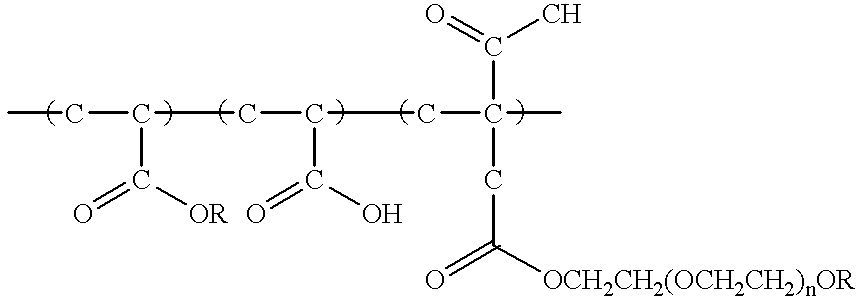Composition and method for whitening teeth
a technology of whitening teeth and composition, applied in the field of dentistry, can solve the problems of decreased peroxide stability, increased ph, and little consumer or professional appeal
- Summary
- Abstract
- Description
- Claims
- Application Information
AI Technical Summary
Benefits of technology
Problems solved by technology
Method used
Image
Examples
example 1
Stabilized hydrogen peroxide (35% aqueous solution commercially available from Degussa under the trade designation PERALKYLI) (1.5 mL) was mixed with 4.4 mL of water. Twenty drops of STRUCTURE.RTM. 3001 rheology modifier were subsequently stirred into the mixture. Twenty drops of sodium hydroxide solution (2.5 g NaOH in 50 mL of water) then were stirred into the mixture, initiating thickening of the mixture. The resulting mixture was capable of remaining in a dental tray when the tray was inverted.
example 2
Example 1 was repeated except that 0.5 mL of glycerin was substituted for 0.5 mL of water.
example 3
Example 1 was repeated except that an aqueous solution of tris(hydroxymethyl)aminomethane was substituted for the sodium hydroxide solution.
When the compositions of Examples 1-3 were painted on stained, extracted human teeth, a visible improvement in whitening occurred within 40 minutes of exposure. This was observed by first splitting the tooth lengthwise, and then placing one half of the tooth in the exemplified compositions and the other half of the tooth into comparative compositions having the same formulations as in Examples 1-3 except that water was substituted for hydrogen peroxide. In addition, the compositions of Examples 1-3 were placed in a stock dental tray and were worn in a human mouth for about 40 minutes. After removal of the dental tray, the soft tissues exhibited no deleterious effects and the teeth were noticeably more white.
PUM
| Property | Measurement | Unit |
|---|---|---|
| composition | aaaaa | aaaaa |
| weight percent | aaaaa | aaaaa |
| concentration | aaaaa | aaaaa |
Abstract
Description
Claims
Application Information
 Login to View More
Login to View More - R&D
- Intellectual Property
- Life Sciences
- Materials
- Tech Scout
- Unparalleled Data Quality
- Higher Quality Content
- 60% Fewer Hallucinations
Browse by: Latest US Patents, China's latest patents, Technical Efficacy Thesaurus, Application Domain, Technology Topic, Popular Technical Reports.
© 2025 PatSnap. All rights reserved.Legal|Privacy policy|Modern Slavery Act Transparency Statement|Sitemap|About US| Contact US: help@patsnap.com

